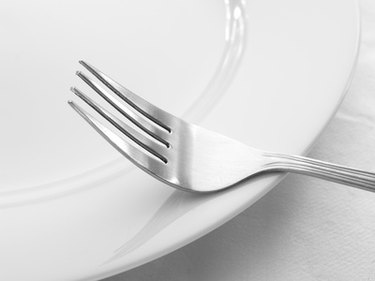Things You'll Need
Dish soap
Rags
Abrasive finishing paper
Porcelain repair kit and applicator brush
Fine grit sandpaper (optional)

Ceramic is a hard, brittle, heat- and corrosion-resistant material made from nonmetallic minerals, such as clay. Porcelain is a translucent, white form of ceramic used as a coating on many household appliances and features, making the surfaces smoother and easier to clean. Ceramic coating has become popular on metallic surfaces such as iron sole plates and stove tops because it conducts heat and distributes it evenly. It also acts a protective nonstick barrier. With frequent and consistent use of these everyday items, you can scratch the thin layers of ceramic, exposing the underlying metal base. You can easily fill and fix some scratches, thereby saving yourself the expense of replacing the entire appliance.
Step 1
Mix warm water with a few drops of dish soap in a bowl. Dip a cleaning rag into the soapy water and use it to clean all grease, dust and dirt in and around the scratch. Dry the surface completely with the dry portion of the towel or let it air dry.
Video of the Day
Step 2
Rub the abrasive finishing paper over the scratch. This will rough up the smooth ceramic surface, allowing the porcelain layers to adhere better.
Step 3
Shake the porcelain repair bottle before opening it, allowing all of the mixture to fall from the bottle's cap for cleaner opening. Open the cap carefully and wipe any drips from the bottle rim immediately so it doesn't harden and make the bottle difficult to close later.
Step 4
Dip the applicator brush tip into the bottle lightly, using only the amount needed to cover the length of the scratch in one thin layer. It is better to cover the scratch in several thin layers than one thick layer.
Step 5
Brush a thin layer onto the scratch beginning at one end and working the brush all the way to the other end of the scratch in one full stroke. If you are unable to cover the length of the scratch in one stroke, dip the brush in porcelain mixture again and continue covering the scratch from where you stopped.
Step 6
Wait approximately one hour after applying the first full layer of porcelain before applying a second or consecutive layer. The surface must be completely dry before applying another layer so the porcelain can adhere completely to the surface.
Step 7
Continue covering the scratch with thin layers until it's form is no longer visible. If the scratch is not deep, you may be able to cover it in just one coat. After you apply the last layer, allow several hours for the surface to dry completely before cleaning and buffing the surface. If desired, sand the surface.
Tip
Some porcelain repair kits give you color options to best match your appliance. Repair kits can contain either a premixed porcelain mixture or components that you must mix by hand.
Drying times vary between repair kits. To decrease the amount of drying time between layer applications, use a blow-dryer on the coolest setting and hold it 12 inches from the wet surface, constantly moving the head around so it doesn't settle on one spot and spread the wet porcelain.
If debris becomes stuck to the porcelain while it's drying, or the surface is not even, use the finishing sandpaper to gently smooth it. Buff it with a soft rag.
For thermal surfaces such as stove tops or grills, use a porcelain repair formula which can sustain high heat around 425 degrees. Check the kit's instruction label for heat sustainability levels.
Maintain the repaired ceramic surface clean afterward with dish soap or another gentle formula to cut down on future damage to the repair.
Warning
Items that have ceramic coatings should not be filled with porcelain if they come into contact with skin or food; for instance, ceramic coated pans or hair irons that become scratched, peeled or are wearing out are poor candidates for this type of repair.
Video of the Day